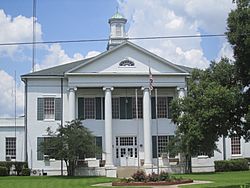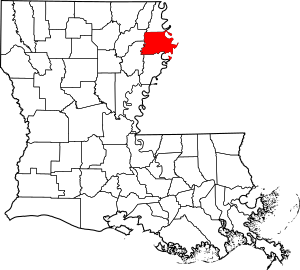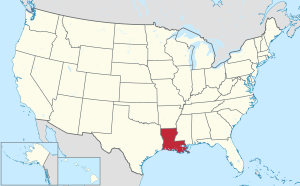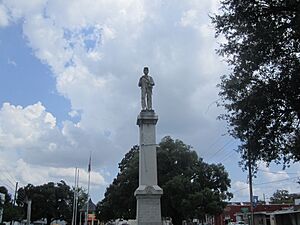Madison Parish, Louisiana facts for kids
Quick facts for kids
Madison Parish
|
|
|---|---|

Madison Parish Courthouse in Tallulah
|
|

Location within the U.S. state of Louisiana
|
|
 Louisiana's location within the U.S. |
|
| Country | |
| State | |
| Founded | 1838 |
| Named for | James Madison |
| Seat | Tallulah |
| Largest city | Tallulah |
| Area | |
| • Total | 651 sq mi (1,690 km2) |
| • Land | 624 sq mi (1,620 km2) |
| • Water | 26 sq mi (70 km2) 4.1% |
| Population
(2020)
|
|
| • Total | 10,017 |
| • Density | 15/sq mi (6/km2) |
| Time zone | UTC−6 (Central) |
| • Summer (DST) | UTC−5 (CDT) |
| Congressional district | 5th |

Madison Parish is a special area in Louisiana. It's on the northeastern edge of the state, right by the Mississippi River. In 2020, about 10,017 people lived here. The main town, or 'parish seat,' is Tallulah. Madison Parish was created in 1839.
For a long time, people grew lots of cotton and pecans here. Even today, farming is the main way people make a living. Most people living in the parish are African Americans. Years ago, a boat called a ferry carried people and cars across the river to Vicksburg, Mississippi. Now, the Vicksburg Bridge helps cars travel on U.S. Route 80 and Interstate 20 into Madison Parish.
Contents
History of Madison Parish
Ancient Times in Madison Parish
Long, long ago, thousands of years before Europeans arrived, many different groups of Native Americans lived in Madison Parish. These groups, like the Marksville, Troyville, Coles Creek, and Plaquemine cultures, built villages and large mounds all over the area. Some famous examples of these ancient sites are the Fitzhugh Mounds and the Raffman Site.
Modern History of Madison Parish

Madison Parish is named after James Madison, who was a former President of the United States. To honor him, the parish courthouse is built in a style similar to old buildings in Virginia. This courthouse is in the middle of downtown Tallulah and faces east. The Tallulah City Hall is also nearby, facing south.
During the American Civil War, Madison Parish was a very rich area because of its cotton farms. Many men from the parish joined the war early on. In 1862, the parish even paid $80 to anyone who joined a Confederate army group.
When the governor of Louisiana, Thomas Overton Moore, realized that New Orleans would be taken by the Union army, he ordered that all the cotton be destroyed. This was to stop the Union from getting it. So, hundreds of thousands of dollars worth of cotton were burned, which made the farmers very sad. Governor Moore also asked a general to gather all available men to help fight off Union attacks in the area.
Towards the end of the war, Madison Parish had problems with groups called "jayhawkers." These were people who supported the Union and hid in the swamps. They would often come out to rob or capture people. To stop them, Confederate soldiers dressed up in Union uniforms to trick them. They surprised the jayhawkers and fought them, stopping their attacks on the area.
For over a hundred years, the Sevier family was very important in Madison Parish politics. They were descendants of John Sevier, a hero from the American Revolution and a governor of Tennessee. Many Sevier family members served in important roles, like state senators, state representatives, and even the mayor of Tallulah. For example, Andrew L. Sevier was a state senator for 30 years, and William Putnam "Buck" Sevier, Jr. was the mayor of Tallulah for many years.
Geography of Madison Parish
Madison Parish covers about 651 square miles. Most of this area, about 624 square miles, is land. The rest, about 26 square miles, is water.
Main Roads in Madison Parish
 Interstate 20
Interstate 20 U.S. Highway 65
U.S. Highway 65 U.S. Highway 80
U.S. Highway 80
Neighboring Areas
Madison Parish shares its borders with other parishes and counties:
- East Carroll Parish (to the north)
- Warren County, Mississippi (to the east)
- Tensas Parish (to the south)
- Franklin Parish (to the southwest)
- Richland Parish (to the northwest)
Protected Natural Areas
Parts of these important natural areas are found in Madison Parish:
- Tensas River National Wildlife Refuge
- Vicksburg National Military Park
Towns and Villages
Cities
- Tallulah (This is the main town, also called the parish seat.)
Villages
Population Changes
Over the years, the number of people living in Madison Parish has changed. Since 1980, the population has gone down by about one-third. This is partly because there are fewer jobs in farming as machines do more work, and a large lumber mill closed down.
In the early to mid-1900s, many African Americans moved away from the area. This was part of a big movement called the Great Migration. They moved to the North and West to find better opportunities and escape unfair treatment.
| Historical population | |||
|---|---|---|---|
| Census | Pop. | %± | |
| 1840 | 5,142 | — | |
| 1850 | 8,773 | 70.6% | |
| 1860 | 14,133 | 61.1% | |
| 1870 | 8,600 | −39.1% | |
| 1880 | 13,906 | 61.7% | |
| 1890 | 14,135 | 1.6% | |
| 1900 | 12,322 | −12.8% | |
| 1910 | 10,676 | −13.4% | |
| 1920 | 10,829 | 1.4% | |
| 1930 | 14,829 | 36.9% | |
| 1940 | 18,443 | 24.4% | |
| 1950 | 17,451 | −5.4% | |
| 1960 | 16,444 | −5.8% | |
| 1970 | 15,065 | −8.4% | |
| 1980 | 15,975 | 6.0% | |
| 1990 | 12,463 | −22.0% | |
| 2000 | 13,728 | 10.2% | |
| 2010 | 12,093 | −11.9% | |
| 2020 | 10,017 | −17.2% | |
| U.S. Decennial Census 1790-1960 1900-1990 1990-2000 2010 |
|||
People in Madison Parish (2020)
In 2020, there were 10,017 people living in Madison Parish. Most of the people were Black or African American (about 61.6%). White people made up about 34.1% of the population. There were also smaller numbers of Native Americans, Asians, Pacific Islanders, and people of mixed races. About 2% of the population was Hispanic or Latino.
Education in Madison Parish
Public schools in Madison Parish are managed by the Madison Parish School Board. They help make sure students get a good education.
Notable People from Madison Parish
- Buddy Caldwell
- Zelma Wyche
See also
 In Spanish: Parroquia de Madison para niños
In Spanish: Parroquia de Madison para niños



